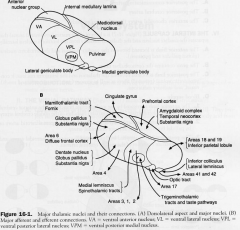![]()
![]()
![]()
Use LEFT and RIGHT arrow keys to navigate between flashcards;
Use UP and DOWN arrow keys to flip the card;
H to show hint;
A reads text to speech;
15 Cards in this Set
- Front
- Back
|
Major Thalamic Nuclei
|

1. Anterior
2. Mediodorsal 3. Centromedian 4. Pulvinar 5. Ventral tier nuclei A. ventral anterior B. ventral lateral C. Ventral posterior; i. ventral posterolateral ii. ventral posteromedial 6. Metathalamus 7. Reticular nucleus of thalamus |
|
|
Anterior Nucleus
|
- INPUT: mamillary nucleus
- TRACT: mamillothalamic - OUTPUT: cingulate gyrus - FUNCTION: part of Papez circuit of emotion of limbic |
|
|
Mediodorsal nucleus
|
LOTS of intralaminar connections
- INPUT: amygdala, substantia nigra & temporal neocortex - OUTPUT: reciprocally connected to prerontal cortex - TRACT: - FUNCTION: expression of affect, emotion & behaviour memory (lost if destroyed) - Werncke Korsakoff Syndrome |
|
|
Centromedian Nucleus
|
largest intralaminar nucleus, recip. connected to 1o motor cortex
- INPUT: GP - OUTPUT: Striatum (CN & Putamen) & diffusely to entire neocortex - TRACT: - FUNCTION |
|
|
Pulvinar
|
largest thalamic nucleus
- INPUT: l & m geniculate bodies & superior colliculus - OUTPUT: recp. connections with the assoc. cortex of parietal, occipital & posterior temporal lobes - TRACT: - FUNCTION: intergration of visual, auditory & somesthetic input - destruction may result in sensory dysphasia |
|
|
Ventral Anterior nucleus
|
- INPUT: GP & Substantia Nigra
- OUTPUT: diffusely to prefrontal cortex, orbital cortex & premotor cortex - TRACT: - FUNCTION |
|
|
Ventral Lateral
|
- INPUT: cerebellum (dentate), GP, SN
- OUTPUT: motor cortex, supplementary motor cortex (BA 6) - TRACT: - FUNCTION |
|
|
Ventral Posterior Nucleus;
2 subnuclei; VPL & VPM |
2 subnuclei; VPL & VPM
- termination point for GSA & SVA (taste) |
|
|
VPL
|
- INPUT: spinothalamic tract & ML
- OUTPUT: sensory cortex - TRACT: - FUNCTION |
|
|
VPM
|
- INPUT: trigeminothalamic tracts
- OUTPUT: sensory cortex - TRACT: - FUNCTION GUSTATORY pathway orginates in solitary nucleus & projects via central tegmental tract to VPM & then gustatory cortex (postcentral gyrus BA 3b). Taste Pathway is ipsilateral |
|
|
Metathalamus
|
LGN: visual relay.
INPUT: retina via optic tract OUTPUT; 1o visual cortex MGN: auditory relay nucleus INPUT: brachium of inferior colliculus OUTPUT: 1o auditory cortex (BA 41, 42) |
|
|
Reticular Nucleus of Thalamus
|
surrounds the thalamus as a thin layer of GABAergic neurons, lies between the extramedullary lamina & IC
- INPUT: excitatory from corticothalamic & thalamocortical fibres - OUTPUT; inhibitory to thalamic nuclei |
|
|
Thalamus BS
|
1. Post. communicating aa
2. Post. cerebral aa. 3. Anterior choroidal aa (LGN) |
|
|
Internal Capsule
|

- layer of white matter separate the caudate & thalamus medially from the lentiform (GP & P) nucleus laterally
A. anterior limb; between caudate & lentiform B. genu; contains corticobulbar fibres C. posterior limb; between thalamus & lentiform. COntains, CsT, sensory (pain, temp, touch), visual & auditory radiations |
|
|
Internal Capsule BS
|
1. anterior limb; medial striate branches of anterior cerebral a & lateral striate from MCA
2. genu; direct branches off ICA or pallidal branches of Ant. Choroidal a 3. Post. limb; Ant. choroidal a & branches off MCA |

